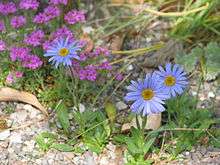Felicia rosulata
Felicia rosulata is a hairy, perennial, herbaceous plant of up to 30 cm (1 ft) high, that is assigned to the daisy family. It has a rosette of elliptic 8 cm × 2 cm (3.1 in × 0.8 in) leaves with 3–5 veins, and long, hairy stalks, each topped with one floral head consisting of about thirty middle blue ray florets encircling many yellow disc florets. It can be found in the mountains of Lesotho, eastern South Africa and Swaziland.[3]
| Felicia rosulata | |
|---|---|
 | |
| Felicia rosulata | |
| Scientific classification | |
| Kingdom: | Plantae |
| Clade: | Tracheophytes |
| Clade: | Angiosperms |
| Clade: | Eudicots |
| Clade: | Asterids |
| Order: | Asterales |
| Family: | Asteraceae |
| Genus: | Felicia |
| Section: | Felicia sect. Dracontium |
| Species: | F. rosulata |
| Binomial name | |
| Felicia rosulata Yeo[1] | |
| Synonyms[2] | |
| |
Description
Felicia rosulata is a perennial, herbaceous plant of up to 30 cm (1 ft) high. Underneath its leaf rosettes with single-headed upright stems, it has short branched rhizomes, and rarely short runners are present too. Most leaves are in a rosette near the base, alternately arranged on the stem, the lower inverted egg-shaped to elliptic, about 8 cm (3 1⁄5 in) long and 21⁄2 cm (1 in) wide (rarely 9 × 3 cm), entire or with teeth along its margins. The leaves at the base each have three or five conspicuous main veins, and their surface is short and densely hairy. The leaves along the stem above the rosette are much smaller, lance-shaped, the lowest up to 3 cm (1 1⁄5 in) long and 4 mm (1⁄6 in) wide, becoming smaller towards the top.[3]
The flower heads sit individually on top of a densely hairy stalk, near to the head also with scattered glandular hairs. The involucre is about 1 cm (2⁄5 in) across, and consists of three rows of about equally long bracts, without resin ducts, covered with long bristly and slightly glandular hairs, less hairy further inwards. Those in the outer and inner rows are about 7 mm (1⁄4 in) long and 1 mm (0.04 in) wide, those in the middle 9 mm (1⁄3 in) long and 2 mm (0.08 in) wide. About thirty female ray florets with a blue strap and a hairy tube. These encircle many bisexual, disc florets with a yellow corolla of 4–5 mm (0.16–0.20 in) long. In the center of each corolla are five anthers merged into a tube, through which the style grows when the floret opens, hoovering up the pollen on its shaft. At the tip of both style branches is a narrowly triangular appendage. Around the base of the corolla are many white, shortly toothed, deciduous pappus bristles. The brown, dry, one-seeded, indehiscent fruits called cypsellae are 3 mm (0.12 in) long and 11⁄2 mm (0.6 in) wide, have a light brown marginal ridge, and the more or less smooth surface carries short hairs.[3]
Felicia rosulata is a diploid having nine sets of homologue chromosomes (2n=18).[3]
Taxonomy
As far as is known, the species was first collected for science by Ferdinand Krauss on the Tafelberg in Natal in 1839. It was described by Carl Heinrich 'Bipontinus' Schultz, who named it Agathaea natalensis in 1843. In 1865, William Henry Harvey, who was a lumper sunk Agataea in Aster, creating the combination Aster natalensis. In 1897, Rudolf Schlechter reassigned it again, now to Felicia, making the combination Felicia natalensis. However, the combination Felicia natalensis had already been created by Bipontinus, also in 1843, a name that is now synonymous with Felicia erigerioides, an older name created by Augustin Pyramus de Candolle in 1836. Therefore, since Felicia natalensis is not available, Peter Frederick Yeo created the new combination Felicia rosulata in 1970. In his 1973 revision of the genus Felicia, Jürke Grau regarded all of these name synonymous.[3]
Distribution
Felicia rosulata can be found in Lesotho, Swaziland, and South Africa (Eastern Cape, Free State, KwaZulu-Natal, Limpopo, and Mpumalanga).[4]
Conservation
The continued survival of Felicia rosulata is considered to be of least concern.[4]
Use
Felicia rosulata is used as an ornamental in rock gardens.
References
- "Felicia rosulata Yeo". The Plant List.
- "Felicia rosulata Yeo". Plants of the World Online. Royal Botanical Gardens Kew. Retrieved 13 January 2019.
- Grau, J. (1973). "Revision der Gattung Felicia (Asteraceae)". Mitteilungen der Botanischer Staatssammlung München. IX: 468–472. Retrieved 2017-11-12.
- "Felicia rosulata". SANBI Red List of South African Plants.